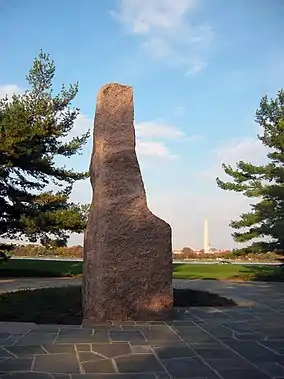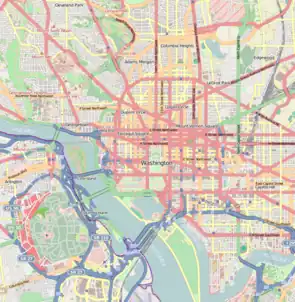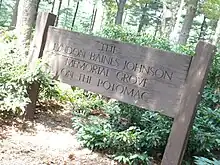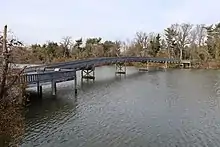Lyndon Baines Johnson Memorial Grove on the Potomac
Lyndon Baines Johnson Memorial Grove on the Potomac is located on Lady Bird Johnson Park (formerly known as Columbia Island), in Washington, D.C. The presidential memorial honors the 36th President of the United States, Lyndon B. Johnson.
| Lyndon Baines Johnson Memorial Grove on the Potomac | |
|---|---|
 LBJ Memorial Grove Monolith | |
  | |
| Location | Washington, D.C., USA |
| Coordinates | 38°52′43″N 77°3′5″W |
| Area | 17 acres (0.07 km2) |
| Established | December 28, 1973 |
| Governing body | National Park Service |
| Website | LBJ Memorial Grove on the Potomac |
The grove consists of two parts. The first area, commemorative in nature, is a Texas granite monolith surrounded by a serpentine pattern of walks and trails. The second area is a grass meadow and provides a tranquil refuge for reflection and rejuvenation of the spirit. The trails are shaded by a grove of hundreds of white pine and dogwood trees, and framed by azaleas and rhododendron. The memorial overlooks the Potomac River with a vista of the city of Washington.
Visitors may listen to a recording made by Lady Bird Johnson at the entrance to the park facing The Pentagon. In the recording, the former First Lady talks about the creation of the park, the trees, and the views of major Washington, D.C., landmarks.
History


Former President Lyndon B. Johnson died on January 22, 1973. Soon after, Johnson's admirers proposed constructing a statue in Washington, D.C., in his memory, but concern that it would be defaced led to rejection of that idea.[1] Brooke Astor and Laurence Vanderbilt suggested a grove of trees instead, and planning for the $2 million grove began in Spring 1973.[2] Lady Bird Johnson Park was chosen as the site of the grove due to Johnson's love of the park and its panoramic views of Washington, D.C., and its monuments on the National Mall and elsewhere while he was president.[3]
The national memorial was authorized by Congress on December 28, 1973, and administratively listed on the National Register of Historic Places the same day.[4]
By February 1975, $1.3 million for the memorial grove had been raised. A $15 silver medal and a $350 gold medal were designed in early 1975 and sold to help raise another $150,000.[5] Plans for the grove were largely complete by May 1975. Landscape architect Meade Palmer designed the grove, which included a contemplative meadow and a small granite plaza among some trees.[6] The grove covered 15 acres (61,000 m2), and would be planted with white pine, dogwood trees, and flowering shrubs and bushes. A granite plaza was intended for the center of the grove, on which a 45-short-ton (41 t), 19-foot (5.8 m) high pink granite orthostat (or "standing stone") quarried in Texas was to be placed. Stone carver Harold Vogel worked the exterior of the stone to give it a dynamic, rough-hewn look reminiscent of Johnson's personality.[7] The Department of Geological Sciences at the University of Texas estimated the rock's age at a billion years.[8] A flagstone walkway winding through the grove was included in the design. Four quotes from Johnson's public speeches, selected by Lady Bird Johnson, were carved into flagstones placed around the orthostat. But $600,000 was still needed in May 1975 to complete the memorial.[7]
The orthostat was delivered to the site in August 1974, and emplaced on August 13, 1975.[9] In December 1975, Congress authorized $1 million to complete the memorial grove and establish a maintenance fund.[10]
The memorial was dedicated on April 6, 1976.[11][12] It is administered by the National Park Service, as part of the George Washington Memorial Parkway.
A $500,000 footbridge between the memorial and a 30-car parking lot along Boundary Channel was constructed to make it easier to visit the Grove. The bridge was designed by landscape architect Meade Palmer and dedicated by Lady Bird Johnson on October 12, 1977.[13][14]
See also
References
- Cheshire, Maxine. "Statue for a 'Man of the People'." Washington Post. April 5, 1973.
- "Oasis In Memoriam." Washington Post. December 7, 1973.
- (1) McPherson, Jr., Harry C. "A Pine Grove by the Potomac." Washington Post. January 22, 1974.
(2) "Part 1 4: Core Components: Lyndon Baines Johnson Memorial Grove on the Potomac" (PDF). Foundation Document: George Washington Memorial Parkway: District of Columbia, Maryland, Virginia. United States Department of the Interior: National Park Service. December 2014. pp. 24–25. Archived (PDF) from the original on July 19, 2021. Retrieved July 19, 2021. - "President Signs Manpower Bill." New York Times. December 29, 1973.
- "Medallions for the LBJ Memorial Grove." Washington Post. February 4, 1975.
- "Lyndon Baines Johnson Memorial Grove" (PDF). United States Department of the Interior: National Park Service. p. 1. Archived from the original (PDF) on May 10, 2015. Retrieved May 8, 2013.
- "The LBJ Grove." Washington Post. May 6, 1975.
- "Lyndon Baines Johnson Memorial Grove." National Park Service. U.S. Department of the Interior. No date, p. 2. Accessed 2013-05-08.
- McCardle, Dorothy. "45-Ton Rock For LBJ Grove." Washington Post. August 14, 1975.
- "Funds for Johnson Grove." New York Times. December 23, 1975.
- "Lyndon Baines Johnson Memorial Grove" (PDF). United States Department of the Interior: National Park Service. p. 2. Archived from the original (PDF) on May 10, 2015. Retrieved May 8, 2013.
- Smith, J. Y. (April 7, 1976). "A Budding Grove". The Washington Post.
- "A Bridge to LBJ Memorial". The Washington Post. September 27, 1977.
- "Correction". The Washington Post. September 30, 1977.
- The National Parks: Index 2001–2003. Washington: U.S. Department of the Interior.
External links
![]() Media related to Lyndon Baines Johnson Memorial Grove on the Potomac at Wikimedia Commons
Media related to Lyndon Baines Johnson Memorial Grove on the Potomac at Wikimedia Commons